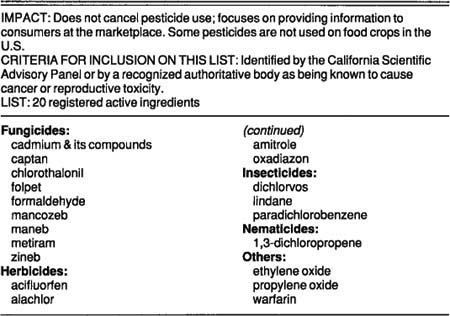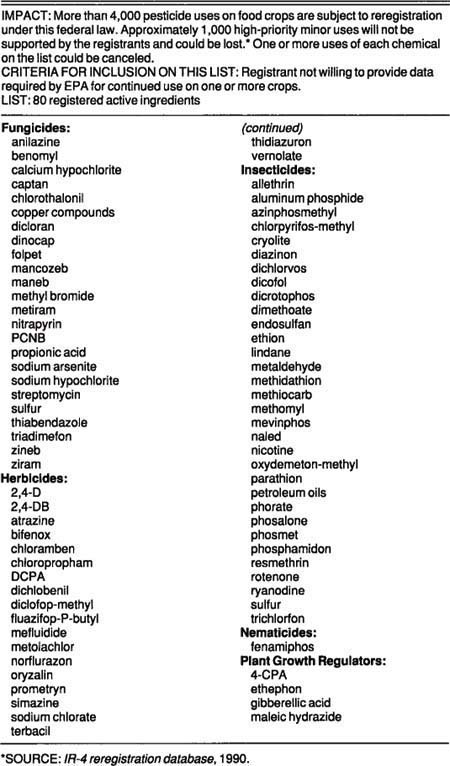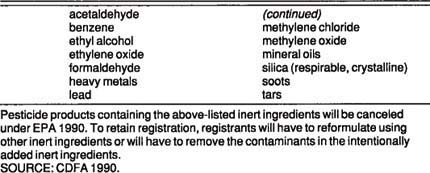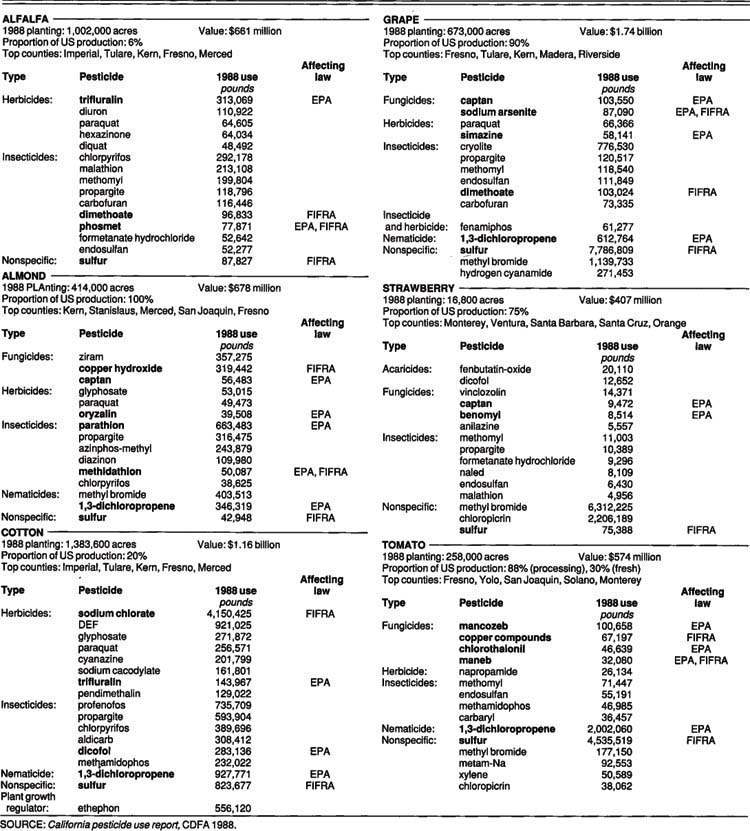All Issues
Potential pesticide use cancellations in California
Publication Information
California Agriculture 44(4):12-16.
Published July 01, 1990
PDF | Citation | Permissions
Abstract
Abstract Not Available – First paragraph follows: Increasingly, pesticide registrations are being rescinded by state and federal regulatory actions and by private sector decisions to withdraw pesticide products. Public concern, regulatory complexity, and scientific understanding of the hazards of pesticides are likely to increase in the near future. California faces the potential loss of a large part of the currently employed chemical pest control technology. An understanding of these pesticide losses will help California's agricultural community identify and adopt effective and acceptable alternative pest management techniques and help the University of California make informed decisions on directing its research and extension resources.
Full text
Increasingly, pesticide registrations are being rescinded by state and federal regulatory actions and by private sector decisions to withdraw pesticide products. Public concern, regulatory complexity, and scientific understanding of the hazards of pesticides are likely to increase in the near future. California faces the potential loss of a large part of the currently employed chemical pest control technology. An understanding of these pesticide losses will help California's agricultural community identify and adopt effective and acceptable alternative pest management techniques and help the University of California make informed decisions on directing its research and extension resources.
We have reviewed the potential impact of two existing laws and one proposed law affecting agricultural pesticide use in California, in order to identify the pesticides that might be targeted for cancellation. These laws are the Safe Drinking Water and Toxic Enforcement Act of 1986 (Proposition 65), the Federal Insecticide, Fungicide, and Rodenticide Act as amended in 1988 (FIFRA 1988), and an initiative measure on the November 1990 ballot, the Environmental Protection Act of 1990 (EPA 1990). The potential impacts of these laws range from a requirement that a warning statement accompany pesticide-treated produce to the partial or complete cancellation of the pesticides' agricultural use.
The three measures may be thought of as a series of progressively more restrictive filters. Pesticide use is currently unaffected under Proposition 65, and many uses of most products will continue beyond the reregistration process required by FIFRA 1988. The active ingredients formulated into hundreds of pesticide products may be canceled if EPA 1990 is adopted by California's voters. Additional withdrawals are possible over time as the laws are interpreted and as pesticide registrants decide to withdraw registrations. Combined, these three laws would result in major modifications of current pesticide use.
Table 1, table 2, and table 3 respectively present our estimate of the chemicals affected by Proposition 65, FIFRA 1988, and EPA 1990, as well as the criteria for inclusion on those lists. The tables summarize potential use cancellations that may result from each of the three laws. Twenty registered active ingredients are covered by Proposition 65. FIFRA 1988 affects 80 registered pesticide ingredients and EPA 1990 could force cancellation of at least 40 active ingredients. No major pesticide classification is exempt; fungicides, herbicides, insecticides, and nematicides all are affected. The total number of registrations, the total number of formulations, and the total number of uses for the active ingredients that may be canceled by FIFRA 1988 and EPA 1990 (table 2 and table 3) have not been determined at this time.
Two existing laws
Proposition 65, the Safe Drinking Water and Toxic Enforcement Act, does not cancel pesticide registrations. The law provides information to consumers at the marketplace and restricts the discharge of certain chemicals into the waterways. The law establishes a scientific advisory panel and requires that the State of California develop a list of chemicals known to cause cancer or reproductive toxicity.
TABLE 4. Inert ingredients causing potential pesticide product cancellations as a result of the Environmental Protection Act of 1990
Under the labeling provisions of the law, any person who may be exposed to a listed chemical at a significant level must be warned of that possibility when any product contains amounts of a chemical on the list that represent a significant risk. Generally, the warnings are signs or labels displayed where the product is sold. Pesticide-treated commodities were exempted from the warning label requirement, but a recent court decision requires such labels on agricultural commodities. That decision is under appeal. The water quality provisions of Proposition 65, if implemented, would impose heavy fines on those responsible for the discharge of a listed chemical into any waterway. Thus, the law established by Proposition 65 does not itself remove pesticides from use. However, growers may be unwilling to use those materials or the manufacturers may withdraw California registrations if they will be subject to commodity labeling requirements, or if they will risk substantial fines as a result of illegal discharges into any waterway.
TABLE 5. Pesticide use on several major California crops for 1988 (those in bold may be subject to cancellation as a result of FIFRA 1988 or EPA 1990)
The Federal Insecticide, Fungicide, and Rodenticide Act was amended in 1988 (FIFRA 1988) to require accelerated reregistration of pesticides for which the U.S. Environmental Protection Agency did not have complete registration data. Federal reregistration is scheduled for completion in 1997. Companies will lose registrations before 1997 if they do not agree to provide data or do not pay reregistration fees. Under FIFRA 1988, cancellations will occur if EPA determines the pesticide should not be reregistered for use. In addition, registrants may voluntarily withdraw pesticide registrations when they estimate that their costs for continued registration exceed potential sales revenue, or when liability outweighs the potential profits.
EPA 1990
If approved by California voters, the Environmental Protection Act of 1990 (EPA 1990) could ultimately be the most far-reaching of these three laws. This measure focuses on the carcinogenic potential of registered pesticides. It would eventually force cancellation of a significant number of pesticides included on the U.S. Environmental Protection Agency's lists of chemicals evaluated for carcinogenic potential. The agency's “A” list is limited to those chemicals known to be human carcinogens. Chemicals on the “B” list are those classified by the agency as probable human carcinogens. Under EPA 1990, registrations of the chemicals on the “A” and “B” lists would be canceled and their tolerances revoked by January 1, 1996. If it were shown at that time that no effective alternative were available, the Director of Health Services could authorize an additional 3 years' use, requiring a 10% reduction in use each year, before cancellation.
For chemicals that are on the agency's “C” list because they are considered possible human carcinogens, the registrants would have to petition for a determination of non-carcinogenicity if they wished to retain registration. Petitions would be due by November 7, 1994. If the chemical were determined to be a probable human carcinogen, its registration would be canceled and its tolerance revoked by the year 2001. The optional 3-year extension could also be authorized. If the chemical were determined not to be a probable human carcinogen, its registration would remain in effect.
EPA 1990 also has a provision stating that all other pesticide tolerances must be evaluated by the State Department of Health Services by January 1, 1997, and revised or revoked by January 1, 1998.
EPA 1990 incorporates the pesticides covered by the Proposition 65 list, and would eventually result in their cancellation. It would also prohibit the importation into California of commodities carrying residues of pesticides on that list or the EPA 1990 list. Most of these cancellations would become effective on January 1, 1996.
Most pesticide formulations include various inert ingredients in order to make effective products. EPA 1990 defines inert ingredients to include any ingredients that are not active, and contaminants, metabolites, or degradation products in the formulated pesticide. Specific information on most inert ingredients is considered a trade secret by manufacturers, and is not publicly available. Some of these inert ingredients are included on the Proposition 65 list; 13 inert ingredients meet the same criteria applied to active ingredients and would be added to the EPA 1990 list (table 4). Other inert ingredients not included in table 4 may eventually be shown to present a risk as defined by EPA 1990, and would therefore be subject to a data call-in to support their continued registration. Registrants may be able to find substitutes for intentionally added inert ingredients prohibited under these laws. If the inert ingredient cannot be removed and if registrants cannot provide the required toxicity data, formulated pesticide products will be canceled by the State of California within two years of the data call-in.
EPA 1990 includes a clause that may eventually prove very significant. The initiative would set the maximum allowable risk of carcinogenicity to an exposed population at one case in one million. This risk would be determined using the most conservative risk assessment model that is accepted as scientifically valid. The initiative states that this”…shall also apply to other adverse health effects of any pesticide as to which there is no generally accepted scientifically valid threshold below which exposure is safe….” Depending on future interpretation, this portion of the initiative could impact any pesticide that shows any measurable neurological, behavioral, or reproductive activity in test animals. It could also affect pesticides shown to be mutagenic in higher organisms. We cannot predict with certainty, however, how this portion of the initiative would be interpreted. Since EPA 1990 includes no provision for review by a recognized scientific advisory organization, the process for establishment of standards and the technical determination of scientifically valid thresholds remains unclear.
Lost technology: industry shifts
These three laws may cause progressive losses of pest management chemicals for the farming industry. Table 5 lists six of California's top-value crops for 1988 and shows their dollar value, acreage, and major pesticide uses, and potential effects of FIFRA 1988 and EPA 1990. Implementing acceptable alternative pest management strategies to replace the targeted pesticides over the next five years would be expensive, and require increased research and extension programs and, perhaps, major adjustments in agricultural production and management systems. The companion article by Zalom and Strand identifies alternatives that UC pest management experts believe might replace the targeted pesticides presented here in table 2 and table 3. Included among these are many technologies that are only partially developed and have not yet proven to be efficacious and economical.
No general statement can be made as to the availability of alternatives. Alternatives can only be approached specifically, crop-by-crop, pest-by-pest. For example, the data presented by Zalom and Strand (their table 1) indicate that chlorothalonil, one fungicide targeted under both FIFRA 1988 and EPA 1990, has two available alternatives (other fungicides) for use on soft fruits, but none for cole crops. In addition, on onions, potatoes, and tomatoes chlorothalonil is important, but we do not know the status of possible alternatives. In short, most pesticide alternatives are very specific in their action, so they must be developed individually for each crop-pest situation.
Whether required immediately as some compounds are withdrawn by their registrants under FIFRA, or more gradually as chemicals are phased out over 5 to 13 years under EPA 1990, the implementation of economically viable alternatives to the pesticides to be removed from use will be expensive and require an accelerated research and development program. However, California's agriculture has proven to be a resilient industry, and with time efficacious and economical alternatives may be developed for the targeted pesticides. The review presented in this paper and the two that follow will help the University develop its research and extension agenda to develop new pest management guidelines to replace those involving the targeted pesticides. Supplying scientifically sound, efficacious, and economical alternatives will be a major challenge.









